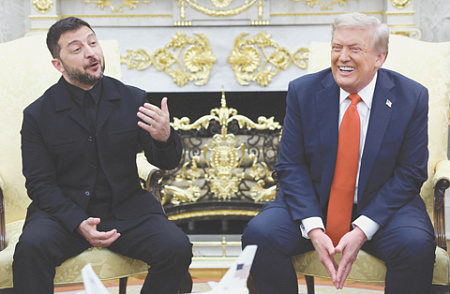
In a significant diplomatic push, U.S. President Donald Trump has outlined a new vision for ending the Russia-Ukraine conflict, centered on a potential three-way summit with his Russian and Ukrainian counterparts. Following high-level talks in the White House with Ukrainian President Volodymyr Zelenskyy and key European leaders, the proposed path forward involves negotiating a security formula for Ukraine that pointedly excludes NATO membership and the deployment of American troops on its territory.
This new phase of negotiations, which followed an earlier meeting between Trump and Vladimir Putin in Alaska, saw a notable shift in tone. Trump has abandoned specific peace deadlines and public criticism of either leader, instead urging “flexibility” from Kyiv and “goodwill” from Moscow. The White House meetings, attended by the leaders of Germany, the UK, France, Finland, Italy, and the heads of the European Commission and NATO, also revealed a dramatically improved rapport between Trump and Zelenskyy. The Ukrainian leader, avoiding past confrontations, praised his American counterpart and concurred on the principle of starting peace talks without a mandatory ceasefire.
Details of the diplomatic roadmap were elaborated on by Finnish President Alexander Stubb, who described a three-step process. The first step involves launching a “substantive conversation about security guarantees for Ukraine.” This would be followed by a proposed bilateral meeting between Putin and Zelenskyy. Should that prove successful, the final step would be a trilateral summit involving Trump, a format the U.S. president appears to be heavily invested in.
In a subsequent interview, Trump reinforced his expectations for the potential talks, hoping Putin would “act well” to avoid an unspecified “tough situation.” He refrained from mentioning sanctions or other forms of pressure, instead emphasizing his belief that the Russian president also seeks to end the war. Trump also reiterated his long-standing positions that Ukraine’s accession to NATO is off the table and that regaining Crimea is “unrealistic,” while avoiding any direct proposals for territorial exchanges.
Despite the flurry of diplomacy, significant ambiguities remain. Neither Trump nor NATO’s chief addressed how the new stance on Ukraine’s membership reconciles with the alliance’s official open-door policy. Moreover, Trump reaffirmed that the conflict is primarily a European responsibility and stated unequivocally that U.S. forces would not be deployed in Ukraine. This complex diplomatic landscape, filled with both cautious optimism and profound uncertainty, was perhaps best symbolized by a map in the White House showing Russian-controlled territories, which observers interpreted in diametrically opposed ways: either as a pragmatic acceptance of reality or as a testament to Ukraine’s enduring resilience.
